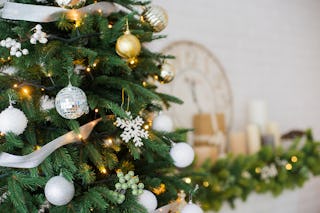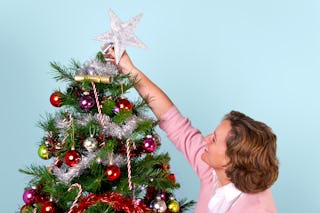
Decorating the Christmas tree is one of the most cherished holiday traditions around the world. Families gather together each year, pull out boxes of beloved Christmas ornaments, and count down the days until Christmas together. Many of these memories form the basis for traditions that are passed down from generation to generation.
But how did ornaments come to play such a large role in our Christmas experiences?

The History of Christmas Ornaments
The idea of decorating a tree for Christmas began in Germany, where they used to add fruits and nuts to trees once the leaves fell off to symbolize the promise of spring to come.
But in 1605, a fur tree was brought inside and adorned with paper roses, candles, nuts, and fruits, which was groundbreaking! The idea of decorating a tree indoors took off and spread across Germany.
In the 1800s, German immigrants brought the tradition to America, who made their own interpretations. Early ornaments were made out of whatever items that families had available to them – fruit (especially apples), nuts, strings of popcorn and cranberries, paper streamers, candles, and metal foil. They really came to show off American inventiveness!
Fun fact: Even before Christmas lights were invented, we loved the idea of lighting up a tree. Bits of foil were often added to reflect the light in the room and make the tree glisten!

Traditional Ball Ornaments
You know those sets of round plastic ornaments you decorate your tree with? Well, those originated in Germany, too!
Hans Greiner started making glass ball ornaments (called baubles) during the 1800s, which became the first manufactured Christmas ornaments. In the late 19th century, the enterprising F.W. Woolworth brought the idea to America, where he sold more than $25 million worth per year.
Eventually, manufacturers began using injection molding (injecting molten material into a mould) with plastic materials, which allowed for a variety of other shapes and sizes.
Fun fact: The round shape of the bauble originates from the shape of the original decorating material – fruits and nuts.

The Christmas Star
You may know that the Christmas star you see perched on top of trees and hung on branches has religious origins, but do you know why?
When Jesus was born in Bethlehem, there were three magi (or wise men) who saw an unusual star in the sky and knew that it would lead them to baby Jesus. They followed that star all the way to the stable where Jesus lay in a manger, and brought gifts of gold, incense, and myrrh. The star that we use to decorate our trees today is representative of the original Star of Bethlehem.
Fun fact: Though we sometimes refer to them as “the three kings”, the wise men were not actually kings. Instead, they were the equivalent of astrologers, who followed the patterns of the stars and were held in high esteem.

Candy Canes
We use candy canes for everything from Christmas tree decorations to stocking stuffers! Another German Christmas tradition, the candy cane originated around 1670. Designed to help children sit still during Christmas services, the candy was shaped like a “J” to represent crooks of the shepherds that visited baby Jesus.
Around 1900, the red stripes and peppermint flavoring were added. Christians believe that the red stripes represent the blood that Jesus shed on the cross and the peppermint flavoring represents the hyssop plant that was used for Biblical purification.
Fun fact: The original candy canes had no flavoring or color and were essentially just “sugar sticks.”

Angels
Many people use beautiful, ornate angels to decorate the top of their tree or to hang intermixed with other ornaments. These, too, have religious connotations.
They can represent the angel that appeared in Bethlehem to announce the birth of Jesus, the angel Gabriel who told Mary she would give birth to Jesus, or even the idea of angels watching over us and protecting us.
Fun Fact: Soon after Christmas trees became popular, parents would decorate trees with streamers, telling their children that the streamers were pieces of angel hair that had been caught in the branches.
The Christmas Pickle
The Christmas pickle is definitely one of the weirdest Christmas ornament traditions! It emerged in the late 19th century as a game that parents created for their children. They bought a glass pickle ornament, hid it inside the tree, where it blended in with the branches, and asked the children to hunt for it. Whoever found the pickle first got an extra gift!
Fun fact: While this was said to be a German tradition, Germany claimed they never heard of it! It’s thought to be the idea of an enterprising salesman who wanted to sell more ornaments.

Contemporary Usage of Christmas Ornaments
Now, Christmas tree ornaments have come to really represent the interests of each individual family. For example, many families collect ornaments throughout their travels as visual representations of memories. Others purchase customized ornaments with the year of anniversaries, births, or other milestones engraved or stamped on them. Ornaments representing interests have become popular too, showcasing sports, movie characters, hobbies, musicians, favorite colors, and more.
Themed trees are a relatively new Christmas trend that’s quickly catching on! You’ll see everything from coastal trees (shells and sand dollars) to retro trees (mercury glass and pastels), movie-themed trees (movie characters and symbols) to rustic trees (pinecones and woodland animals). They’re really becoming representations of each individual family’s interests and preferences.
Fun fact: Hallmark Keepsake ornaments originated in 1973 with a small line of glass ball ornaments and yarn figures. Since then, over 8500 ornaments have been introduced, used to celebrate milestones by families all over the world.